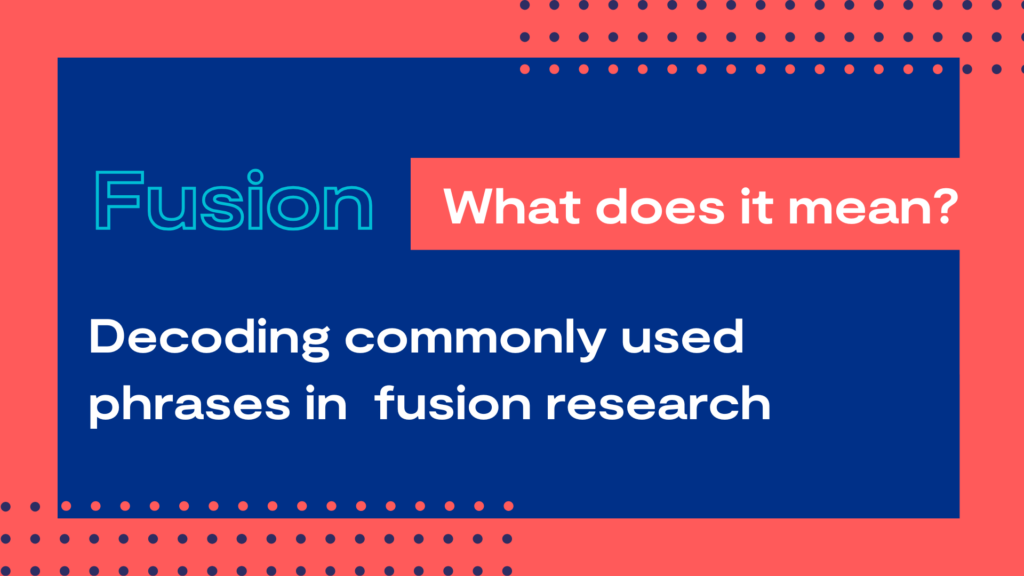Fusion | What does it mean? Decoding commonly used phrases in fusion research

As a part of our collaboration with the UK Atomic Energy Authority (UKAEA) we are working together to develop digital solutions to help make commercial fusion energy a reality. One day fusion could power our planet with clean, limitless energy using the same process that powers the stars. But fusion science comes with its own language, which can sometimes feel like a universe of its own. Here, we breakdown fusion terminology and share how our experts are working with UKAEA to advance digital technologies and help pave the way to a more energy-efficient future.
Fusion
“The constellations carry us back to the dawn of astronomy. They have been called the fossil remains of primitive stellar religion, and as such they have extraordinary interest.”
Ceclia Payne-Gaposchkin, Astronomer who discovered that stars were composed primarily of hydrogen and helium
Fusion is a natural process that powers the sun and other stars. More specifically, it is the process of combining two atomic nuclei to form a heavier nucleus, releasing a large amount of energy. This reaction has the potential to provide a nearly limitless source of clean energy. In many ways, fusion would be the ideal energy source offering a sustainable and powerful solution for the future.
Tokamak
“I would like nuclear fusion to become a practical power source. It would provide an inexhaustible supply of energy, without pollution or global warming.”
Stephen Hawking, Theoretical Physicist who discovered black holes have a temperature and produce radiation
To make fusion energy a reality, we need to find a way to harness the energy of the stars. The aim of fusion devices is to replicate the process of combining atomic nuclei from stars. The most promising approach involves a tokamak, a device designed to contain and control plasma using powerful magnetic fields. It is estimated that if we could harness fusion for energy generation, we could meet the energy needs of the world for more than a million years using hydrogen from seawater. Fusion produces no greenhouse gases or long-lasting radioactive waste and carries no risk of runaway reactions, making it a safe and sustainable energy source.
Plasma
“Solids, liquids, and gases make up the three familiar states of matter, but the most common form of matter in the universe is plasma, a gas of ionised atoms.”
Michio Kaku, Theoretical Physicist, Futurologist and the Co-Founder of string field theory
The fuel that powers tokamaks is plasma, the fourth state of matter. Plasma forms when gas is heated to extreme temperatures, causing atoms to lose their electrons and create a mix of free electrons and charged particles. This highly energetic state is crucial for fusion energy, as it enables atomic nuclei to collide and fuse, releasing immense amounts of energy, just like in the Sun. However, plasma is incredibly dynamic and difficult to control, constantly shifting and reacting to magnetic and electric fields. We use digital technologies like generative AI to help understand how plasma behaves and how to control it at high temperatures and pressures required for a stable fusion reaction, bringing us closer to a future of clean, abundant energy.
Magnetic confinement
“There is stardust in your veins. We are literally, ultimately children of the stars.”
Jocelyn Bell Burnell, Astrophysicist who discovered the first radio pulsars
For tokamaks to work, they need to be able to contain the plasma, which generates the power of the fusion device. One of the best ways to do this is with powerful magnetic fields. Magnetic confinement is a method used to control high-temperature plasma in tokamaks by using strong magnetic fields. This prevents the plasma from coming into contact with the walls of the reactor and losing heat.
Digital Twin
“To me, programming is more than an important practical art. It is also a gigantic undertaking in the foundations of knowledge.”
Grace Hopper, Computer Scientist, United States Navy Rear Admiral and creator of the first computer compiler
A digital twin is a virtual representation of a physical system that is continuously updated with real-time data. It helps researchers and engineers simulate and optimise complex systems before making changes in the real world. We are developing a digital twin of a tokamak to help advance fusion energy research. By creating a highly accurate, data-driven model, we can reduce the need for expensive real-world prototyping and gain deeper insights into how a fusion device operates in real-time. This technology enables us to predict and refine the behaviour of plasma, optimise reactor performance, and accelerate progress towards sustainable fusion energy. Watch our experts explain how we are building a digital twin of a fusion device and explore some of the cutting-edge technologies making it possible.
FAIR Data
“Science is a communal effort. Collaboration and shared knowledge are essential for progress.”
Vera Rubin, groundbreaking Astronomer who made significant contributions to our understanding of dark matter
FAIR Data refers to data that is findable, accessible, interoperable and reusable. It ensures that scientific data can be easily shared and used by researchers and organisations to support innovation and collaboration. There are millions of datasets worldwide that have been created but remain inaccessible or unusable. Despite their vast potential, difficult-to-access data is a well-documented and ongoing challenge in research communities. When researchers cannot find or use existing data, it slows the pace of scientific discovery and can lead to unnecessary duplication of efforts. Our researchers are working to make fusion research data more FAIR, ensuring that valuable insights can be shared, built upon and used to accelerate progress in fusion energy.
Join Newsletter
Provide your details to receive regular updates from the STFC Hartree Centre.

